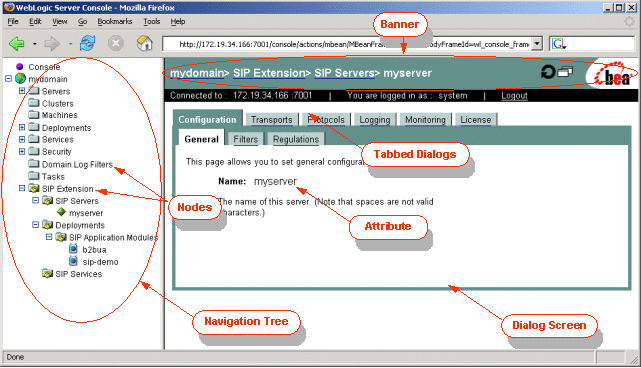| SIP Servlet Engine© Documentations |
| Top > System Administration > Configuration > Administration Console |
Administration Console
Overview
BEA WebLogic Server Administration Console is a browser-based graphical user interface for managing the WebLogic Server domains. In SIP Servlet Engine, the standard Administration Console is extended with additional proprietary Administration Console screen and navigation elements.
Visual Elements of Administration Console

How to Use Administration Console
For details on usage of Administration Console, see "Administration Console Online Help."
Deployment
EJB Modules
The Service Provider Interfaces (SPIs) used when accessing the database are deployed as EJB modules.
 sip-spi-ejb
sip-spi-ejb- The EJB module that provides the Service Provider Interface.
 sip-spi-mdb
sip-spi-mdb- The message-driven Bean that provides the Service Provider Interface.
Web Application Modules
When you install SIP Servlet Engine, the following Web application modules are deployed.
 sip-console
sip-console - The SIP extension of Administration Console.
 sip-digest
sip-digest - The interface for using the presence ACL management component of SIP Servlet Engine from OKISoftphone.
When you install a demo application, the following Web application modules are deployed.
 sip-admin
sip-admin - A demo application which uses the user management, location management and presence ACL management of the Service Provider Interface (SPI) provided with SIP Servlet Engine. This application also works as an administration tool when performing SIP-based real-time communication.
 sip-demo
sip-demo - A demo application which uses the SIP signaling component that is the basic component provided with SIP Servlet Engine.
 sip-docs
sip-docs - Online document for SIP Servlet Engine.
Starting and Shutting Down
The engine portion of SIP Servlet Engine (SIP servlet container) is closely linked with WebLogic Server, and thus its life cycle is synchronized with the instance of WebLogic Server by the following startup and shutdown classes.
 SIP Admin Service Startup
SIP Admin Service Startup - Registers SIP-related MBean common to WebLogic domains upon starting up the administration server.
 SIP Admin Service Shutdown
SIP Admin Service Shutdown - Registers SIP-related MBean common to WebLogic domains upon shutting down the administration server.
 SIP Service Startup
SIP Service Startup - Starts up the SIP servlet container when starting WebLogic Server.
 SIP Service Shutdown
SIP Service Shutdown - Shuts down the SIP servlet container when shutting down WebLogic Server.
Service
JDBC
The Service Provider Interface (SPI) of SIP Servlet Engine (deployed as EJB) uses the data source to access the database. During installation, the following connection pool and data source are configured.
Connection Pool
 LocationServer ConnectionPool
LocationServer ConnectionPool - A connection pool associated with the data source "LocationServer."
Data Source
 LocationServer
LocationServer - A data source defined with connection pool name "LocationServer ConnectionPool" and JNDI name "locationServet.dataSource."
JMS
SIP Servlet Engine uses JMS to notify applications of the information such as the Register state of users. The connection factory, JMS store and JMS server as described below are used right after installation. By checking the JMS destination, you can monitor and control JMS.
Connection factory
 ConnectionFactory
ConnectionFactory - The connection factory defined by the JNDI name ConnectionFactory.
Store
 EquipsStore
EquipsStore - The path name of the directory on the file system in which JMS file store is maintained is equipsstore.
Server
 EquipsJMSServer
EquipsJMSServer - The JMS server that has the topic Equips Event at the JMS destination. It is associated with the store ConnectionFactory.
Security
For more information about using the security features, see Security Management.
Authentication provider
 FormAuthenticator
FormAuthenticator - The authentication provider used when performing the FORM authentication via Web. It checks and authenticates that the user name sent via FORM authentication is a user registered in SIP Servlet Engine.
 SipAuthenticator
SipAuthenticator - The authentication provider used when authenticating the SIP request. It is invoked from the authentication manager and checks that the user who sent an SIP message is a user registered in SIP Servlet Engine.
Role mapping provider
 SipRoleMapper
SipRoleMapper - The role mapping provider which maps the role to the SIP request. It grants the role assigned by authorization manager on SIP Servlet Engine to the user who sent the SIP message.
SIP Extension
The extension settings specific to SIP Servlet Engine can be managed in the following screens.
SIP Server --> Configuration --> General
SIP Server --> Configuration --> Filters
SIP Server --> Configuration --> Regulations
SIP Servers --> Transports --> SIP
SIP Servers --> Protocols --> SIP
SIP Servers --> Logging --> Servers
SIP Servers --> Logging --> SIP
SIP Servers --> Logging --> Applications
SIP Servers --> Monitoring --> SIP
SIP Servers --> Monitoring --> SIP Request
SIP Servers --> Monitoring --> SIP Response
SIP Servers --> License --> Engine
SIP Servers --> License --> User
SIP Servers --> License --> Registrar
 Deployment
Deployment
Deployment --> SIP Application Modules
Deployment --> SIP Application Modules --> Configuration --> General
Deployment --> SIP Application Modules --> Configuration --> Descriptor
Deployment --> SIP Application Modules --> Monitoring --> SIP Request
Deployment --> SIP Application Modules --> Monitoring --> SIP Response
 SIP Service
SIP Service
SIP Service --> Proxy
SIP Service --> Load Balancer
Last Modified:Mon Jan 10 19:11:56 JST 2005
| Copyright © 2003, 2004 Oki Electric Industry Co.,Ltd. All rights reserved. |